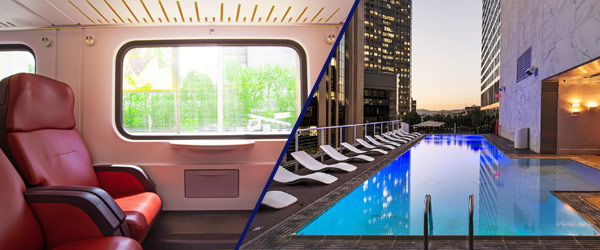
Alicante
Alicante
THE CITY
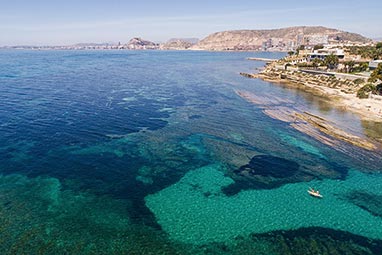
Capital of the Costa Blanca, bathed by the Mediterranean Sea, Alicante is a city that shows the traces of all the different civilisations that have passed through these lands. This can be seen in the numerous archaeological remains and museums which keep this fascinating past alive. A pleasant character, an excellent climate, spectacular beaches, unequalled natural surroundings, a rich historical heritage and exquisite Mediterranean gastronomy have made Alicante one of the most popular tourist destinations not just in Spain, but in all Europe.
The offer of hotels, leisure and fiestas, as well as the commercial activity, is as varied as they could be, as are the sporting activities available here. Chief among them are, above all, nautical sports, whose highpoint was the departure of the Ocean Race in 2021, and the impressive offer of golf and other open-air sports.
To all of these qualities must be added the modern transport infrastructure, including the AVE, which bring fast, easy connections with other Spanish and European capitals. Alicante has moved with the times and has become the home of the European Union Intellectual Property Office (EUIPO).
THE SPRING GOES ON
The climate in Alicante is one of the most benign in Europe, with an average annual temperature of over 18º C and more than 3,000 hours of sunshine a year. An excellent place to enjoy this perfect weather is on a visit to the Island of Tabarca, which has a regular boat service from the city port. Its city centre has been declared a Historical-Artistic Complex and a Site of Cultural Interest and the excellent quality of its waters and the biodiversity of flora and fauna have earned it the declaration of Mediterranean Marine Reserve.
ESSENTIALS

The origins of the city go back to Arabic times, when the population settled on the foothills of Mount Benacantil, on the summit of which the Castle of Santa Barbara was built. On the sides of the mountain the Vila Vella was constructed, which, after the Christian conquest in 1247, became Vila Nova. From that time on, the city grew and developed until it became the important urban nucleus that it is today. This historical legacy is kept alive in the different historical museums of Alicante, such as the MARQ, the Provincial Archaeological Museum, (declared European Museum of the Year 2004), the MUBAG, the Gravina Fine Arts Museum, and the MUSA, the City of Alicante Museum, housed in the Castle of Santa Barbara. As well as these, there are avant-garde centres such as the MACA, the Alicante Contemporary Arts Museum and the Volvo Ocean Race Museum, a modern exhibition centre where visitors can enjoy learning interactively about the marine world, the depths of the seas and intrepid sailors. Other museums and cultural centres that pique the curiosity of visitors to Alicante are the Fogueres Museum, devoted to the bonfires of St John’s night, the city’s main fiestas, which have been declared of International Tourist Interest, the Nativity Museum and the Alicante Water Museum. Lastly, the old tobacco factory, now converted into the Las Cigarreras Cultural Centre, must not be missed, with its multifunctional auditorium for music and theatre.
But the greatest museum of all is the streets and plazas of the city itself, where visitors can stroll through the history of Alicante. The Santa Maria Basilica, constructed on the site of the old mosque, and the Co-Cathedral of San Nicolas are outstanding monuments of the city. The Castle of St Barbara sits on the summit of Mount Benacantil and is one of the symbols of the city. It is one of the largest mediaeval fortresses in Spain and has enormous strategic value. It can be accessed by car or on foot, using a lift excavated in the rock opposite the Postiguet beach. The Castle offers unbeatable views of the city and the Bay.
With a little luck, your stay in Alicante may coincide with one of the city’s numerous fiestas. The main celebrations are on St John’s Day, when the bonfires burn. On the night of 24 June, large satirical figures made of wood and cardboard are put to the flame. These fiestas also include the usual bullfights and, between 25 and 29 of June, there are thousands of fireworks shows, each competing with the others. Throughout the year, the different city neighbourhoods hold the Moors and Christians celebration, a festive commemoration of the struggles between Muslims and Christians in the 13th century, with spectacular parades. The most outstanding is that held on 6 December, St Nicholas’s Day, the patron saint of the city. Easter week is also an important celebration in Alicante, with over 30 brotherhoods which organise the processions, many of which wind through the steep, narrow streets of the Santa Cruz district. After Easter week, two weeks after Easter Thursday, is the Peregrina, a popular pilgrimage to the Monastery of Santa Faz, where, according to tradition, the cloth used by Veronica to wipe the face of Jesus is kept.
GET MOVIN!
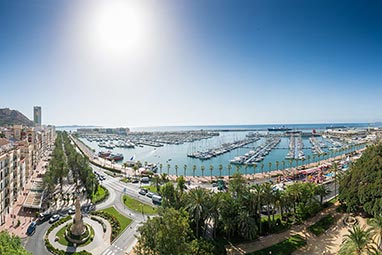
The railway station in Alicante is found in the heart of the city’s shopping district, and so it is the ideal transport for an easy visit. The high-speed train connects Alicante with Madrid in a little over two hours. The station is just a short walk from all the main parts of the city, and there is also a complete network of city buses and trams that connect with the whole of the metropolitan area.
ALTERNATIVES
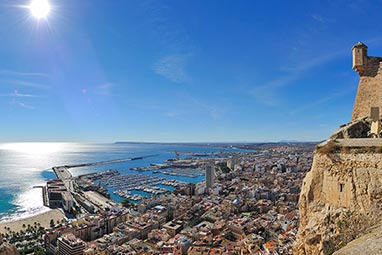
Nature has blessed Alicante with numerous beaches which are always an excellent alternative so you can combine city sightseeing with a stroll on the seaside. Year after year, these beaches are recognized by the European Union, which awards them Blue Flags. From the busiest to the most solitary and hidden away, the beaches are, without doubt, one of the best-known images of the city. The outstanding city beach is El Postiguet, opposite the Castle of Santa Barbara, flanked by a seafront promenade. El Postiguet joins up with the Albufereta beach, the seven-kilometer San Juan beach, which is the best known, El Saladar-Urbanova beach and the coves at Cabo de la Huerta.
FLAVOURS
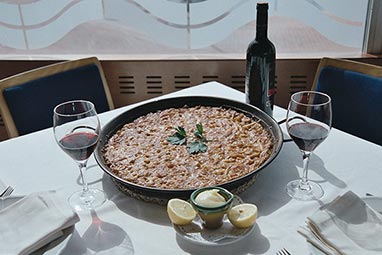
World famous for its health benefits, the Mediterranean diet is at the forefront of local Alicante cuisine thanks to the produce of its fertile lands and the harvest of the sea. Rice is definitely the big attraction, accompanied by fish and shellfish. The popular olleta mixes vegetables and pulses, washed down with Alicante’s own Designation of Origin wines. Special mention must be made of the famous Alicante turrones, an almond-based sweet, which are a special favorite in Spanish homes at Christmas time. As well as these are the artisan ice creams and horchata, a refreshing drink made with ground tigernuts, essential on long summer walks. The most traditional dishes include the outstanding coca amb tonyina, a juicy tuna pasty.
DON’T MISS
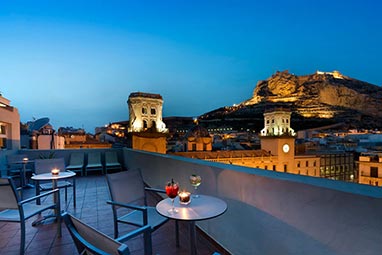
The name of Alicante can be found in many cities and towns throughout Spain when referring to altitude. It is one of the curiosities of the city: Alicante City Hall, a beautiful 18th-century Baroque palace, houses the point from which the altitude above sea level is measured all over Spain. This reference point, called Cota Cero, or Level Zero, is marked on the first step of the main stairway of the building. As a result, numerous buildings all over the country gave their altitude as “above sea level at Alicante”. A guided, dramatised visit to the Castle of Santa Barbara or the historical city centre, or a bicycle tour with one of our guides will be an unforgettable experience.








